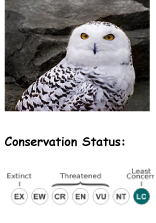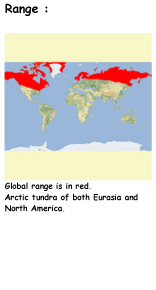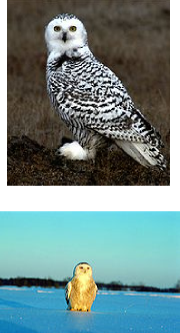Learn About Snowy Owls
The Snowy Owl (Bubo scandiacus) is a large owl that was first classified in 1758 by Carolus Linnaeus, the Swedish naturalist who developed binomial nomenclature to classify and organize plants and animals.
The Snowy Owl is the official bird of Quebec.
This yellow-eyed, black billed white bird is easily recognizable. It is 53-65 cm long with a 125-150 cm wingspan. Also, these birds can weigh anywhere from 1.8-3 kg (3.5-6.6 lbs). The adult male is virtually pure white, but females and young birds have some dark scalloping; the young are heavily barred, and dark spotting may even be predominate. Its thick plumage, heavily-feathered feet, and coloration render the Snowy Owl well-adapted for life north of the Arctic Circle.
Snowy Owl calls are varied, but the alarm call is a barking, almost quacking krek-krek-krek-krek; the female also has a softer mewling pyee-pyee-pyee-pyee or prek-prek-prek. They may also clap their beak in response to threats or annoyances. While called clapping, it is believed this sound may actually be a clicking of the tongue, not the beak.
The Snowy Owl is typically found in the northern circumpolar region. However, it is a particularly nomadic bird, and because population fluctuations in its prey species can force it to relocate, it has been known to breed at more southerly latitudes.
This species of owl nests on the ground, building a scrape on top of a mound or boulder. A site with good visibility, ready access to hunting areas, and a lack of snow is chosen. Gravel bars and abandoned eagle nests may be used. Breeding occurs in May, and depending on the amount of prey available, clutch sizes range from 5 to 14 eggs, which are laid singly, approximately every other day over the course of several days. Hatching takes place approximately five weeks after laying, and the pure white young are cared for by both parents.
This powerful bird relies primarily on lemmings and other rodents for food, but as opportunistic hunters, they will prey on a variety of other animals. Some of the larger mammal prey includes mice, hares, muskrats, marmots, squirrels, rabbits, prairie dogs, rats, moles, and entrapped furbearers. Birds include ptarmigan, ducks, geese, shorebirds, ring-necked pheasants, grouse, American coots, grebes, gulls, songbirds, and short-eared owls. Snowy Owls are also known to eat fish and carrion. Most of the owls’ hunting is done in the “sit and wait” style; prey may be captured on the ground, in the air or fish may be snatched off the surface of bodies of water using their sharp talons. Each bird must capture roughly 7 to 12 mice per day to meet its food requirement and can eat more than 1,600 lemmings per year!
Snowy Owls, like many other birds, swallow their small prey whole. Strong stomach juices digest the flesh and the indigestible bones, teeth, fur, and feathers are compacted into oval pellets that the bird regurgitates 18 to 24 hours after feeding.
Though Snowy Owls have few predators, the adults are very watchful and well equipped to defend against any kind of threats towards them or their offspring. During the nesting season the owls face Arctic foxes and swift-flying jaegers and must be very careful not to leave their eggs unattended. Environmental conditions also cause local threats of food shortages, but their ability to be mobile permits them to move to areas were supplies may be more sufficient. Human activities probably pose the greatest danger to these birds, through collisions with power lines, fences, automobiles, or other structures that impose on their natural habitat. Now, Canadian provincial and territorial regulations have introduced prohibitions of killing of these birds in all parts of Canada, where they are most abundant.
This species is an extremely important component to the food web in the tundra ecosystem and during its visits to the south, the Snowy Owl may play a useful role in the natural control of rodents in agricultural regions.

Scientific Classification:
- Kingdom: Animalia
- Phylum: Chordata
- Class: Aves
- Order: Strigiformes
- Family: Strigidae
- Genus: Bubo
- Species: B. scandiacus


References: *Weir, Ronald D. “Snowy Owl.” Hinterland Who’s Who. 7 May. 2008. *”Snowy Owl.” National Georgraphic. 7 May. 2008. *Frost, Helen. Snowy Owls. Mankato, Minn: Capstone Press, 2007. *Lewis, Diane P. “Snowy Owl – Bubo scandiacus.” The Owl Pages. 7 May. 2008.

